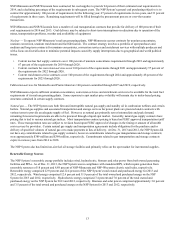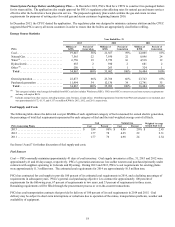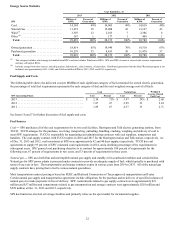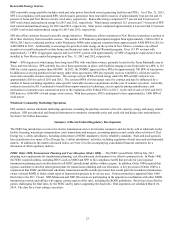Xcel Energy 2013 Annual Report Download - page 35
Download and view the complete annual report
Please find page 35 of the 2013 Xcel Energy annual report below. You can navigate through the pages in the report by either clicking on the pages listed below, or by using the keyword search tool below to find specific information within the annual report.17
The CPUC provided final approval to PSCo's plan in December 2013, which includes the following:
• The addition of 450 MW of wind generation PPAs. This additional wind would bring the installed capacity on PSCo’s
system in Colorado to 2,650 MW;
• The addition of 170 MW of utility-scale solar generation PPAs. PSCo currently has about 80 MW of utility-scale solar and
approximately 188 MW of customer-sited solar generation;
• The addition of 317 MW of natural gas fired generation PPAs, which would come from existing power plants that previously
supplied PSCo, but at reduced prices;
• Accelerated retirement of the 109 MW, coal-fired Unit 4 at the Arapahoe generating station, which occurred at the end of
2013;
• Confirmation of the retirement of the 45 MW, coal-fired Unit 3 at the Arapahoe generating station, which occurred at the end
of 2013; and
• The continued operation of Cherokee generating station’s Unit 4 as a natural gas facility after 2017.
In addition, PSCo continues to execute on the remaining aspects of CACJA compliance including the construction of a new natural
gas fired combined cycle unit at Cherokee generating station and the addition of emissions controls at the Pawnee and Hayden
stations. PSCo also expects to retire the Cherokee Unit 3 and Valmont Unit 5 coal-fired power plants by the end of 2015 and 2017,
respectively.
Boulder, Colo. Municipalization Exploration — PSCo’s franchise agreement with the City of Boulder expired on Dec. 31, 2010. In
November 2010, the citizens of Boulder voted to impose an occupational tax to replace franchise fee revenues that would terminate
when the franchise agreement terminated. In November 2011, two ballot measures were passed by the citizens of Boulder. The first
measure increased the occupation tax to raise an additional $1.9 million annually for funding the exploration costs of forming a
municipal utility and acquiring the PSCo electric distribution system in Boulder. The second measure authorized the formation and
operation of a municipal light and power utility and the issuance of enterprise revenue bonds, subject to certain restrictions, including
the level of initial rates and debt service coverage.
Boulder Staff have performed a feasibility study on municipalization and in July 2013, recommended that Boulder create its own
electric utility. In August 2013, the Boulder City Council voted to authorize the acquisition of PSCo’s transmission and distribution
system in and near Boulder. On Jan. 6, 2014, Boulder sent PSCo a Notice of Intent to Acquire (NOIA) for PSCo’s transmission,
distribution and property assets within an area that includes Boulder and certain areas outside city limits. The NOIA is a legal
prerequisite to the filing of an eminent domain proceeding in Colorado courts. However, sending the NOIA does not require Boulder
to move forward with a condemnation case.
Boulder’s municipalization plan assumes that Boulder will acquire through condemnation PSCo facilities (and customers currently
served from these PSCo facilities) that are located outside Boulder’s incorporated limits. PSCo petitioned the CPUC for a declaratory
ruling that Boulder cannot serve PSCo’s customers outside Boulder’s city limits without obtaining a CPCN from the CPUC. The
CPUC declared that it has jurisdiction under Colorado law to determine the utility that will serve customers outside Boulder’s city
limits, and will determine what facilities need to be constructed to ensure reliable service. The CPUC stated it believes that the cost of
all new facilities must be paid by Boulder. The CPUC declared that it should make its determinations prior to any eminent domain
actions. On Jan. 15, 2014, Boulder appealed this ruling to Boulder District Court.
If Boulder commences an eminent domain proceeding, PSCo will seek to obtain full compensation for the business and its associated
property taken by Boulder, as well as for all damages resulting to PSCo and its system. PSCo would also seek appropriate
compensation for stranded costs with the FERC.
RES Compliance Plan — Colorado law mandates that at least 30 percent of PSCo’s energy sales are supplied by renewable energy by
2020 and includes a distributed generation standard. The CPUC has approved PSCo’s 2012 and 2013 RES compliance plan to acquire
up to 30 MW of customer-sited solar projects each year and up to 9 MW of community solar garden projects, which PSCo met in both
2012 and 2013. The CPUC also approved moving solely to a pay-for-performance basis under the Solar*Rewards distributed solar
generation program, which PSCo implemented in 2012. Based on CPUC approval, PSCo implemented a solar gardens program called
Solar*Rewards Community, which will allow customers to join together to own interests in a common solar facility and receive a
credit related to their share of the solar garden’s electric production on their electric bill. See Renewable Energy Sources for further
discussion.
In July 2013, PSCo filed its 2014 RES compliance plan which included continuing both the Solar*Rewards and Solar*Rewards
Community programs, maintaining approximately the same capacity expected to be installed in 2013. PSCo also proposed to show in
aggregate the system costs that are not avoided by distributed solar generation, which PSCo has defined as a “net metering incentive.”
In December 2013, parties including the OCC filed answer testimony supporting PSCo’s net metering proposal. However, rooftop
solar advocates opposed it and also argued for higher solar installation levels and a slower reduction in incentives over time. Hearings
are anticipated later in 2014 with a decision anticipated in the third quarter of 2014.
























